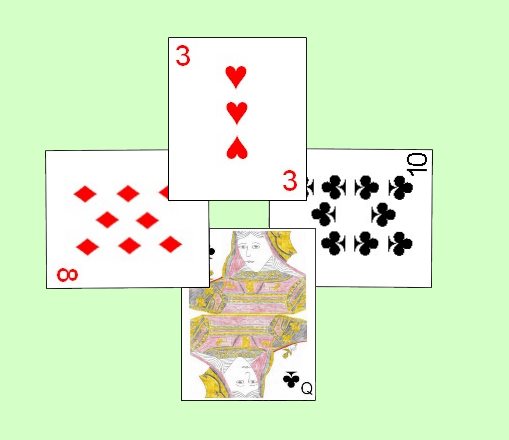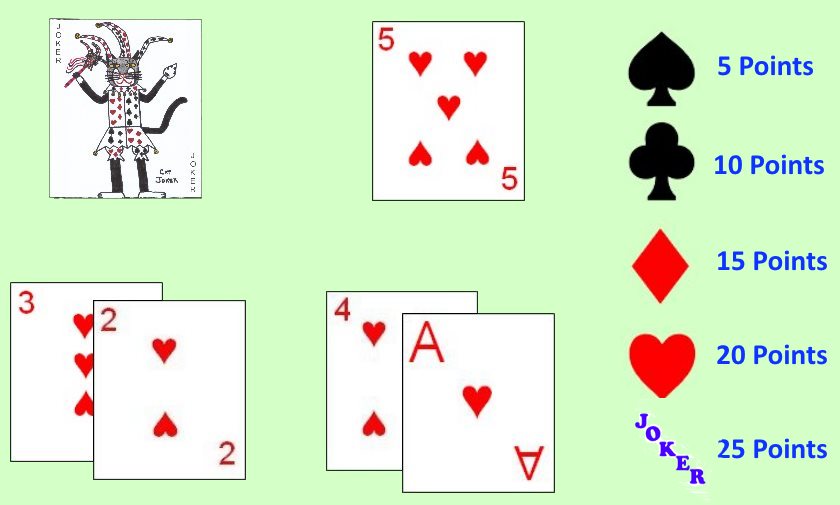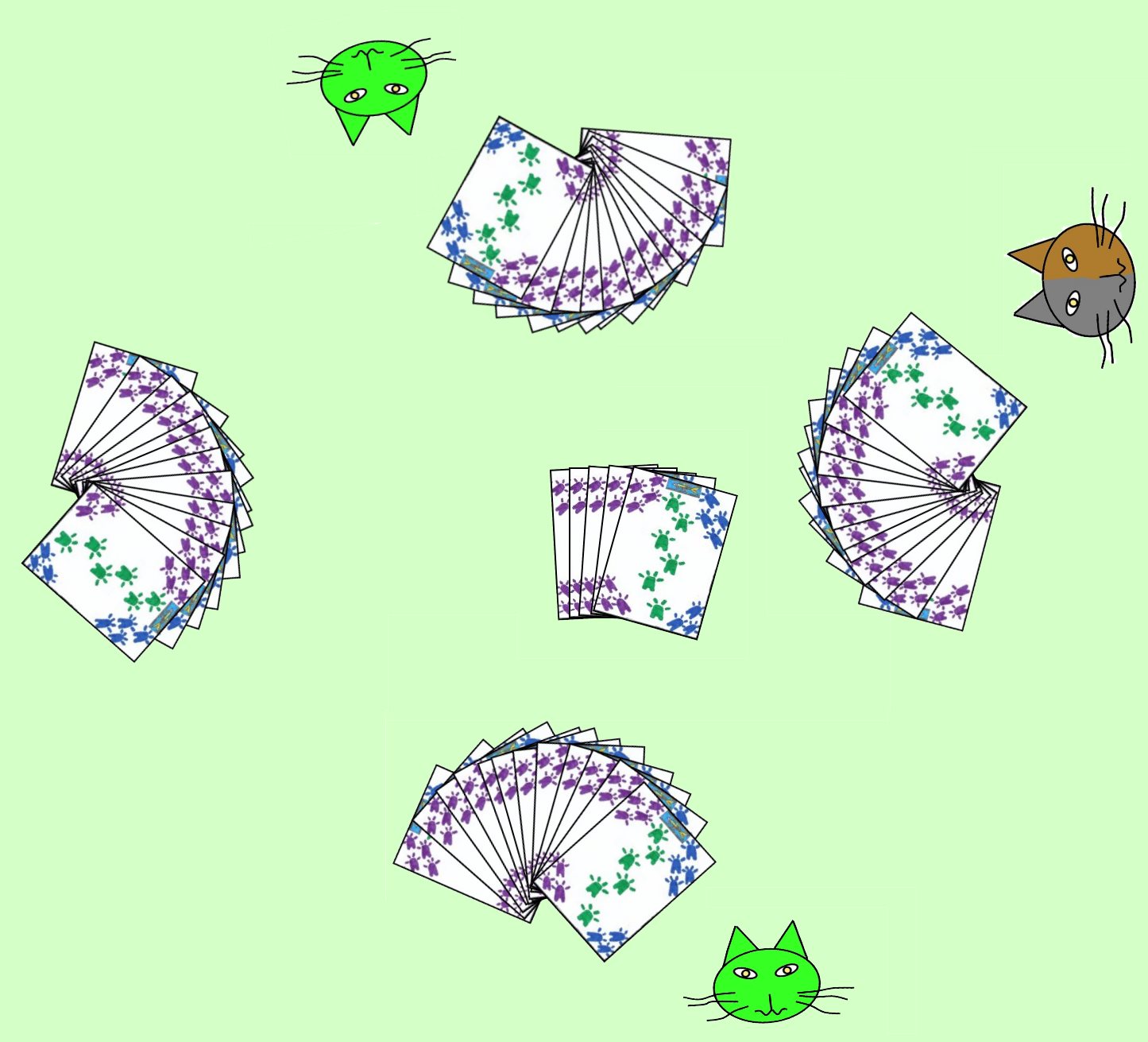 Quinto is a trick taking game for four players, playing in two partnerships. The game is played using one standard 52 card deck with the addition of one Joker. One of the first unique features of this game, is that, while there is not necessarily the concept of a trump suit in the game, every card in the deck has a relative ranking to any other card in the
deck. Thus, the ranking of the cards in each suit are as follows (from high to low): Ace, King, Queen, Jack, 10, 9, 8, 7, 6, 5, 4, 3, 2. Each suit within the game has a ranking as well, shown as follows (also listed high to low); Hearts, Diamonds, Clubs, Spades. The Joker is a special card, which may never be led to a trick, and it's attributes will be described further below.
Quinto is a trick taking game for four players, playing in two partnerships. The game is played using one standard 52 card deck with the addition of one Joker. One of the first unique features of this game, is that, while there is not necessarily the concept of a trump suit in the game, every card in the deck has a relative ranking to any other card in the
deck. Thus, the ranking of the cards in each suit are as follows (from high to low): Ace, King, Queen, Jack, 10, 9, 8, 7, 6, 5, 4, 3, 2. Each suit within the game has a ranking as well, shown as follows (also listed high to low); Hearts, Diamonds, Clubs, Spades. The Joker is a special card, which may never be led to a trick, and it's attributes will be described further below.
The first order of business is usually, if this has not been predetermined, to decide the partnerships to be used for the game. This can be done by requiring each player to draw from the shuffled deck. The players drawing the two highest cards play as partners against the players drawing the two lowest cards drawn. The player drawing the highest card of all becomes the first dealer. Each player should sit directly across the table from his partner for the game.
After partnerships have been determined and the players seated, the dealer thoroughly shuffles the deck and offers the deck to the player at his right. This player cuts the cards and the dealer completes the cut. After the cut, the dealer then begins dealing the cards in a clockwise direction around the table starting with the player to his immediate left. He deals the cards one-at-a-time and face down to each player, continuing until each player has exactly 12 cards. He then places the remaining five cards in the deck face-down in a small pile in the center of the table. This extra hand is called the cachette.
After the cards have been dealt, each player has one opportunity to request a Double for the hand. The player to the immediate left of the dealer has the first opportunity, and this option rotates in a clockwise direction around the table until each player has had the opportunity to request a Double. If a player prefers not to Double, he may simply say Pass. A Double indicates that the point value for each won trick during the hand will be doubled. After a previous player has opted to Double, a member of the opposing team may opt to Redouble. Redoubling again doubles the point value for each won trick during the hand. After each player has this opportunity for doubling, any doubles or redoubles should be duly noted and the play of the hand can begin.
 The player to the immediate left of the dealer leads the first card to the first trick. He may lead any card of his choice from his hand. Each subsequent player, in proper rotation then plays one card from his own hand to the trick. If a player has a card of the same suit originally led to the trick he must play that card. If he does not have such a card he may play any other card from his hand. After each player has played a card to the trick, the winner of the trick can be determined. As mentioned previously, while there is no specific trump suit, each card in the deck has a relative ranking to any other card. Thus, the trick is won by the player of the highest card to that trick. This may end up being a card of the suit led or another suit played to the trick because that player had no card of the suit originally led to the trick. The player who wins the trick begins the next trick by playing any card of choice remaining in his hand.
The player to the immediate left of the dealer leads the first card to the first trick. He may lead any card of his choice from his hand. Each subsequent player, in proper rotation then plays one card from his own hand to the trick. If a player has a card of the same suit originally led to the trick he must play that card. If he does not have such a card he may play any other card from his hand. After each player has played a card to the trick, the winner of the trick can be determined. As mentioned previously, while there is no specific trump suit, each card in the deck has a relative ranking to any other card. Thus, the trick is won by the player of the highest card to that trick. This may end up being a card of the suit led or another suit played to the trick because that player had no card of the suit originally led to the trick. The player who wins the trick begins the next trick by playing any card of choice remaining in his hand.
As mentioned previously the Joker is a special card. It may never be led to a trick and is considered the lowest ranking card in the deck so will never win any trick when played to it. It can be played by the owner of that card on his turn, to any trick. If the owner of the Joker finds that the Joker is still in hand on the 11th trick, and any other card played to the trick would win that trick, he must play the Joker on that trick to prevent from winning the trick and thus be forced to lead the Joker on the last trick (which is otherwise an illegal play).
The objective of both teams during the game is to earn points during and at the conclusion of the hand. The first way a partnership can earn points during a hand is to win tricks containing Quints.
Quints: A Quint is a special card or combination of cards found in a specific trick won by a player. The Joker is considered a Quint by itself, as is any five. In addition, any two cards, of the same suit, which sum to a value of five is considered a Quint. Thus, a three and a two (of the same suit) make a Quint as do a four and an Ace (Ace is considered to have a value of one for the purpose of forming Quints) of the same suit. All cards comprising the Quint must be in the same trick to be considered a valid Quint and a specific trick could possibly have more than one Quint within it. The points for a Quint are scored immediately when the trick is captured by a partnership. The value of the Quint varies based on the specific suit of the cards making up that Quint. The following chart shows the value of a Quint as would be scored in each suit:
|
 |
Whichever player wins the last trick of the hand, also takes the cachette after winning the trick. This cachette is considered the last trick of the hand, and is thus examined for any quints which the team who receives the cachette can also score for.
After all tricks have been played and won, each team scores 5 points for each trick won during the hand. The cachette is also considered a trick won by the team who takes it. Each trick won earns a side 5 points for the feat. However, if any player had doubled during the doubling round this hand, each trick scores 10 points instead. Similarly, if a double was subsequently redoubled on this hand, each trick is worth 20 points instead.
The first team to score 250 or more points is declared the winner. As mentioned previously, any Quints are scores immediately when capturing the trick containing then. However, the points earned for winning of tricks is accumulated by all players at the same time at the end of the hand. Thus, if one team manages to reach or exceed 250 points when scoring a Quint, that team is instantly declared the winner. If a team manages to reach or exceed 250 points at the end of the game, they are also considered the winner. If both teams manages to reach or exceed 250 points at the end of the hand, the team with the higher accumulated score is declared the winner. If both teams have the exact same score (which is at or over 250), another hand must be played to determine the winner of the entire game.
Variations and Optional Rules
 Three Player Quinto: A three player variant of Quinto is also sometimes played, called Three Hand Quinto or Dummy Quinto. In this variant the game is played by two players in partnership who play against one lone player who plays with the aid of a dummy hand.
Three Player Quinto: A three player variant of Quinto is also sometimes played, called Three Hand Quinto or Dummy Quinto. In this variant the game is played by two players in partnership who play against one lone player who plays with the aid of a dummy hand.
Thus, the two partners should sit directly across from each other and the third player sits to either side. Four hands are still dealt out as at the standard variant of Quinto, with a dummy hand dealt directly across the table from the lone player. All hands are dealt face-down normal. The game is played in the normal method, however the lone player plays both his own hand and the dummy hand in the proper turn. To determine which player will play alone for the first hand, the players should all draw cards from the shuffled deck. The players drawing the two highest cards will play as partners against the third player (who will also play the dummy hand). The lone player deals the first hand of each game and for each subsequent hand during that game the deal rotates around the table from player to player in a clockwise direction around the table, however the deal bypasses the dummy hand.
The dummy hand is not exposed during play (as in Contract Bridge), but rather left face down, and the lone player simply picks up that hand in it's turn, playing a card from that hand. Because the lone player actually has an advantage in knowing the cards in two hands, the opponent partnership receives a 25 point handicap added to their score before play begins.
The game is played identically to the standard game with the following differences from the standard four player variant:
- The round of doubling occurs as normal, however the lone player must make his bid based on the hand he is dealt and may not look at the dummy hand until play of the hand begins. In other words the lone player must make his decision on whether he intends to double or redouble based solely on his own hand.
- Rubbers are not played but each "Game" won is a complete game. After each "Game" is completed (which may take several hands to complete), a new game is begun. The player to the left of the previous lone player becomes the new lone player and the other two players play in partnership. As before, the lone player is the first dealer of the first hand, and the opposing partnership starts the game with a 25 point handicap.
- A number of games should be played such that each player has the same number of opportunities to be the lone player.